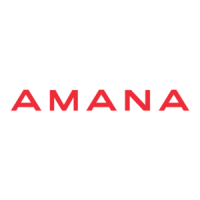5
• The vent system is permanently installed per these
installation instructions.
• A room thermostat is used to control the furnace.
Fixed jumpers that provide continuous heating
CANNOT be used and can cause long term
equipment damage. Bi-metal thermostats, or any
thermostat aected by vibration must not be used
during construction.
• Return air ducts are provided and sealed to the
furnace.
• A return air temperature range between 60ºF (16ºC)
and 80ºF (27ºC) is maintained.
• MERV 11 pleated minimum 4.0” thick (Example
P/N AMP-11-2025-45) air lter(s) are installed in
the system and inspected daily and replaced as
needed during construction and upon completion of
construction.
• The input rate and temperature rise are set per the
furnace rating plate.
• The furnace must be installed as a two pipe system,
using 100% outside air for combustion during
construction.
The furnace heat exchanger, components, duct
system, air lters and evaporator coils are thoroughly
cleaned following nal construction clean up by a
qualied person.
• All furnace operating conditions (including ignition,
input rate, temperature rise and venting) are veried
by a qualied person according to these installation
instructions.
• Furnace doors must be in place on the furnace while
the furnace is operating in any mode.
• Damage or repairs due to failure to comply with these
requirements are not covered under the warranty.
• Gas furnaces must be installed by a licensed plumber
or gas tter.
• A T-handle gas cock must be used.
• If the unit is to be installed in an attic, the passageway
to and the service area around the unit must have
ooring.
In their absence, follow
the latest edition of the National Fuel Gas Code (NFPA 54/
ANSI Z223.1), and/or CAN/CSA B149.1-15 Installation
Codes, local plumbing or waste water codes, and other
applicable codes.
Furnace Alone
- - -
Furnace + 1 Stage Non-Communicating A/C
Furnace + 2 Stage Non-Communicating A/C
Furnace + 1 Stage Non-Communicating H/P
Furnace + 2 Stage Non-Communicating H/P
Furnace + Communicating A/C
Furnace + Communicating H/P
Furnace + Communicating A/C Inverter
Furnace + Communicating H/P Inverter
Table 1
This furnace is primarily designed for residential home-
heating applications. It is NOT designed or certied for
use in mobile homes, trailers or recreational vehicles.
Neither is it designed or certied for outdoor applications.
The furnace be installed indoors (i.e., attic space,
crawl space, or garage area provided the garage area is
enclosed with an operating door).
This furnace can be used in the following non-industrial
commercial applications: schools, oce buildings,
churches, retail stores, nursing homes, hotels/motels,
common or oce areas.In such applications, the furnace
must be installed with the following stipulations:
• It must be installed per the installation instructions
provided and per local and national codes.
• It must be installed indoors in a building constructed
on site.
• It must be part of a ducted system and not used in a
free air delivery application.
• It must not be used as a “make-up” air unit.
• It must be installed as a two-pipe systems for
combustion air.
• All other warranty exclusions and restrictions apply
This furnace is an ETL dual-certied appliance and is
appropriate for use with natural or propane gas
Dual certication means that the combustion air inlet pipe
is optional and the furnace can be vented as a:
Non-direct vent (single pipe) central forced air furnace in
which combustion air is taken from the installation area or
from air ducted from the outside or,
Direct vent (dual pipe) central forced air furnace in which
all combustion air supplied directly to the furnace burners
through a special air intake system outlined in these
instructions.

